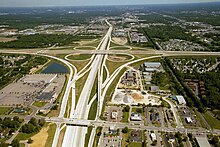
Back Детелина (пътен възел) Bulgarian Kløverbladsanlæg Danish Autobahnkreuz#Kleeblatt German Neliapilaliittymä Finnish Klaverblêd (knooppunt) Frisian מחלף עלה תלתן HE クローバー型 Japanese Klaverbladknooppunt Dutch Węzeł drogowy#Koniczynka Polish Fyrklöver (väg) Swedish
This article needs additional citations for verification. (October 2022) |







A cloverleaf interchange is a two-level interchange in which all turns are handled by slip roads. To go left (in right-hand traffic; reverse directions in left-driving regions), vehicles first continue as one road passes over or under the other, then exit right onto a one-way three-fourths loop ramp (270°) and merge onto the intersecting road. The objective of a cloverleaf is to allow two highways to cross without the need for any traffic to be stopped by traffic lights. The limiting factor in the capacity of a cloverleaf interchange is traffic weaving.